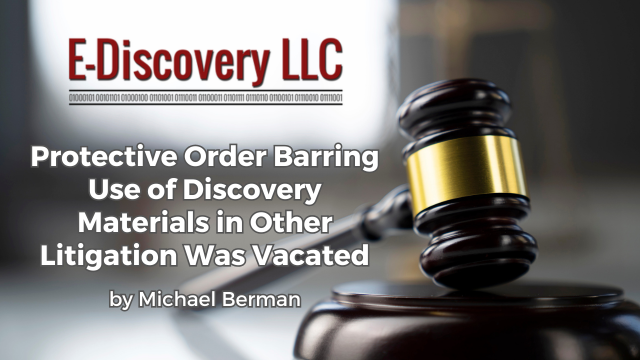
[EDRM Editor’s Note: The opinions and positions are those of Michael Berman.]
A protective order barring post-settlement use by plaintiffs’ counsel of defendant’s discovery responses in other litigation was vacated in Cordero v. Stemilt AG Services, LLC, __ F. 4th__, 2025 WL 1902292 (9th Cir. Jul. 10, 2025).
Columbia Legal Services (“Columbia”) is part of a network of attorneys that provide legal services to marginalized groups. It had represented plaintiffs in a consolidated class action against Stemilt. Two protective orders were entered and the case later settled.
In the second protective order:
[T]he district court concluded that Columbia should “not have free [rein] to utilize the information and documents discovered in this action in other advocacy with which Plaintiffs are not involved.” To address concerns about use of discovered information outside the suit at issue, the court ordered: “Plaintiffs must seek leave of this Court before they—or counsel—utilize discovery from this action in other advocacy.” The district court warned it would “grant leave only in limited circumstances.”
Id. at *2.
Columbia – the legal services organization – appealed in its own name.
The Ninth Circuit wrote: “The question before us concerns the district court’s limitation, contained in the second order, on Columbia’s use outside the class action of information obtained during discovery. Columbia contends that the protective order entered by the court with respect to use of discovered material is overly broad. For the reasons that follow, we agree.” Id.
The question before us concerns the district court’s limitation, contained in the second order, on Columbia’s use outside the class action of information obtained during discovery. Columbia contends that the protective order entered by the court with respect to use of discovered material is overly broad. For the reasons that follow, we agree.
Cordero v. Stemilt AG Services, LLC, __ F. 4th__, 2025 WL 1902292 (9th Cir. Jul. 10, 2025).
First, the Ninth Circuit noted an exception to the rule that generally “only parties at the time judgment was entered have standing to appeal.” Id. at *3. The exception is for attorneys “aggrieved” by an order or judgment: “To have standing, attorneys must show injury to themselves rather than to their clients.” Id. Here, the order was directed to both plaintiffs and Columbia specifically. Id. Columbia submitted an affidavit stating that the protective order had a “tremendous chilling effect” on its advocacy in other matters.
The Ninth Circuit held that Columbia had appellate standing, writing: “Columbia clearly has an interest in using the information revealed in discovery in the class action, and, given the order entered by the district court, the only way it can vindicate that interest is to appeal from the district court’s order.” Id. at *4.
Second, after rejecting a waiver argument, the Ninth Circuit wrote: “We now turn to the protective order itself. Columbia challenges only the following sentence contained in the district court’s second order: ‘Before Plaintiffs or Plaintiffs’ counsel utilize discovery from this matter in other advocacy, Plaintiffs must seek leave of this Court.’” [Emphasis added].
The Ninth Circuit wrote:
It is “well-established” in our case law that discovery is “presumptively public.” San Jose Mercury News, Inc. v. U.S. Dist. Ct.—N. Dist. (San Jose), 187 F.3d 1096, 1103 (9th Cir. 1999). “Generally, the public can gain access to litigation documents and information produced during discovery unless the party opposing disclosure shows ‘good cause’ why a protective order is necessary.” Phillips ex rel. Ests. of Byrd v. Gen. Motors Corp., 307 F.3d 1206, 1210 (9th Cir. 2002). Our court “strongly favors access to discovery materials” for individuals engaged in other litigation because “[a]llowing the fruits of one litigation to facilitate preparation in other cases advances the interests of judicial economy by avoiding the wasteful duplication of discovery.” Foltz v. State Farm Mut. Auto. Ins. Co., 331 F.3d 1122, 1131 (9th Cir. 2003). Despite a presumption of public access, courts can issue protective orders to “protect a party or person from annoyance, embarrassment, oppression, or undue burden or expense” resulting from public disclosure of information obtained during discovery. Fed. R. Civ. P. 26(c)(1).
Id.
The Ninth Circuit requires a showing of “good cause” to restrict access to discovered information. Id. at *5. A party seeking to restrict access must show prejudice “for each particular document it seeks to protect.” Id. If a court then finds “particularized harm” it must balance the public and private interests. Id.
Applying those principles:
Here, the district court entered a broad and undifferentiated order prohibiting Columbia from using any information and documents obtained in discovery in this case without prior approval from the district court. The order included only a brief explanation and no finding of good cause to support this prohibition. The district court did not identify any prejudice or particularized harm that would result from Columbia’s use of or public access to particular documents or information, and it did not balance the relevant interests against any potential harm. We therefore conclude that the district court erred in thus restricting Columbia’s use of information and documents obtained in this litigation.
Id.
The Ninth Circuit vacated the challenged part of the protective order and remanded for further proceedings. Presumably, on remand, the producing party may attempt to meet its burden of proof.
Thanks to Daniel Seiden for reporting on this decision. Order Limiting Use of Discovery Post-Case Ruled Too Restrictive (Jul. 11, 2025).
Assisted by GAI and LLM Technologies per EDRM GAI and LLM Policy.


